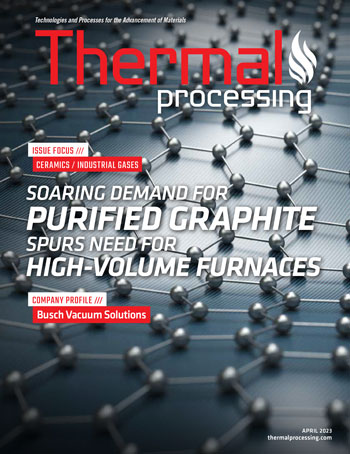
Hitchiner Manufacturing’s motto is, “imagination in metallurgy.” As a heat treater, there are certainly opportunities to use a bit of creativity in creating a process that yields a successful outcome in the customers’ requirements. In his book “Creativity: The Psychology of Discovery and Invention”, psychologist Mihaly Csikszentmihalyi defines creativity as “any act, idea or product that changes an existing domain or that transforms an existing domain into a new one.”
The heat-treat domain is the black and white customer specification — the pyrometry requirements of AMS2750, and metallurgical understanding of thermodynamics and kinetic principles, along with the people involved with all of the creation, maintenance, and implementation of these items.
And it can be seen from the customer’s basic drawing requirement of only mechanical properties that the heat treater must be creative in determining the methodology for heating up the furnace and fixturing the parts to minimize distortion in meeting such requirements.
But Csikszentmihalyi defines this sort of creativity with a lower case “c”. Not that this type of creativity isn’t valued. Instead, creativity with a capital “C” represents the impact of such novel ideas on the overall culture.
So how can we do this for the employees? How can a culture come alive with such a strong desire to see a process grow and find everyone engaged toward a successful heat treat of parts meeting customer demand? Where furnaces are almost singing when parts go in and out with effortlessness and ease? Where the timing of pyrometry testing such as SATs (system accuracy test) or even TUSs (temperature uniformity survey) don’t miss the Takt time of production, the steady heartbeat for moving parts through a given process? Where the environment does truly feel like imagination in metallurgy?
Csikszentmihalyi shows us a way to create such an environment through four components to be practiced every day, at every level of the organization.
I. Promote Curiosity and Interest
“Try to be surprised by something every day.”
For example, when we have an issue with the furnace — say, the ohm reading on the rear element is not reading right — our first reaction isn’t to get all frustrated and bent out of shape knowing we will get scolded for missing production that day. Instead, allow this to challenge our thinking. Be surprised in the sense that something of opportunity can be taken from this. What part of the maintenance program can we improve upon?
“Try to surprise at least one person every day.”
This one can be tricky. Most people think the only thing employees look forward to most are their weekends, vacations, and their paychecks. Surprise them by remembering something they did last weekend as you work together on a particular heat-treat setup that takes a long time to build. Surprise them by showing up and being present, ready to go, and take on the day’s challenges. It doesn’t always have to be a gift card around the holidays or bonus after each year.
II. Creation of Flow
“Wake up in the morning with a specific goal to look forward to.”
Work provides clear goals. With clear goals, the expectations are straightforward. However, goal setting can be challenging sometimes as the black and white numbers of heats to produce each day become monotonous. Shake it up sometimes by making small games throughout the day, by spending time building a cycle with the operators to liven up the energy. Shake it up by giving a special assignment during a heat-treat cycle to be on the watch for thermocouple behavior and atmosphere irregularities on special heat-treat cycles. Everyone wants to continually learn on some level.
“If you do anything well, it becomes enjoyable.”
These little goals start to add up. I have seen operators go from being students in the classroom of my training on heat-treat to being
engineers or technicians by simple application of continuing to build on what they enjoy doing. Even operators who don’t view their
careers as technicians or engineers still thrive in knowing that
what they do they can still be engaging every day. This mindset can be taught.
“To keep enjoying something, you need to increase its complexity.”
This engagement is achieved through adding a little complexity each time to a given task. For the engineer, give them a sense of design in the experiments. Build upon layers of more integration of awareness of customer specifications and metallurgical phenomena.
 III. Habits of Strength
III. Habits of Strength
“Take charge of your schedule.”
Scheduling is probably the most challenging thing I see at work with employees, even with well laid out goals. With expectations of production numbers, boss’ expectations, and where a person is that day, empowering the employee to own what they are going to do comes with encouragement and building a desire to want to do it. Make it bite-size chunks toward achieving the main goal.
“Make time for reflection and relaxation.”
This is often best expressed when allowing time for proper reflection. We recently had a thermocouple failure and, before panicking when Operations was going to arrive screaming, we took a little bit of time to relax and think about the situation as it was new and different. Coming from this place, we were then able to make the best decision that has now been integrated into the practice.
“Find out what you like and what you hate.”
This time of reflection is critical for the employee in that we begin to see what he or she does like or maybe even hates.
“Start doing more of what you love, less of what you hate.”
Recognizing these patterns, employees can now begin to embark down a path of growth.
IV. Problem Solvers
“Constantly surprised.”
Problems arise on this path all the time. Often, we are surprised by them. But imagine seeing instead an opportunity for a new solution.
“Implement the solution.”
To be Creative — with a capital “C” — in the world of heat treat, we must continue to encourage the imagination of the employees with proper understanding of pyrometry, metallurgical, and customer-related requirements as they continue to solve the everyday challenges of heat treat.


























